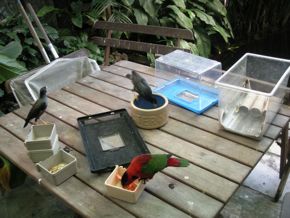The first part of the series by aviculturist Lee Chiu San deals with whether birds can be tamed and whether they will remain tamed. The second part looks at whether it is desirable to tame birds. This third and final part deals with whether attempts should be made to tame wild birds.
“I am sure that controversy will be aroused between those who say that bird-watching should entail nothing more than what the description entails, and others who set out bird tables and bird feeders to attract subjects for a better view.
“I am one of the latter. For years I used to offer my aviary left-overs to a large flock of feathered visitors. I still do on a smaller scale as I am now in-between houses after retirement.
“These are some of the problems I have encountered.
“For a start, you either need to be a good distance from, or a good understanding with your neighbours. Not everybody likes a whole row of expectant avians jostling for position on their eves, and leaving droppings on their cars and laundry. Singapore birds are typical of the citizenry, and quickly form an unruly crowd whenever there is a regular supply of freebies (left).
“And by the way, feeding of pigeons outside your own home is illegal.
“Regular feeding will change the composition of the avifauna of an area. Very quickly, Spotted Dove (Streptopelia chinensis), Common (Acridotheres tristis) and Javan Myna (Acridotheres javanicus), and Eurasian Tree Sparrow ( Passer montanus) will be over-represented. On the other hand, Zebra Dove (Geopelia striata) and smaller general feeders such as the Yellow-vented Bulbul (Pycnonotus goiavier), will be under-represented.
“Regular feeding will endanger some of the birds. I used to attract wild, free-flying Oriental Magpie Robin (Copsychus saularis) to my garden. Obviously, poachers must have noticed this because the birds promptly vanished. I also interacted with some mynas and Spotted Doves to the point where they became as tame as hand-raised baby birds. Those individuals also vanished.
“Nowadays, I simply leave the food and watch from a distance.
An Utopian wish.
“In an ideal world I would like to have free-flying birds that come to my garden regularly for food and which will be unafraid of people so as to allow close approach. I have been to resorts and nature reserves in other countries where the managements strictly enforce rules against molesting wildlife. In such places, wild birds mingle freely with people.
“But in Singapore, until there is a considerable change in human mindset, this is not likely to be easily achievable with species that are either of value, or large and impressive. Despite vigilance, and help from the police, poachers have managed to make off with almost all the songbirds that come to my bird table.
“And if your bird table becomes too popular, attracting species such as crows and pigeons that are deemed to be pests by the Singapore government, someone in the neighbourhood might call in the pest controllers, who will lay poison indiscriminately, and even the harmless species might perish.
“Large birds like egrets and doves attract unwelcome attention from citified children whose ignorant parents do nothing whatsoever to dissuade them from running after the birds.
“So far, the only birds whose company I have managed to enjoy without incident are sunbirds. Plantings of hibiscus, water cannas (Thallia dealbata) and other nectar-bearing plants have enabled my garden to support several generations of sunbirds which are very trusting and build their nests even in areas of high human traffic.
“Let’s work towards getting to the bird watchers’ paradise one day.”
Lee Chiu San
Singapore
May 2010










2 Responses
Take a look at the hanging parrot whaich I captured this morning and the long tailed parakeet.Not sure if I identified the parakeet correctly,